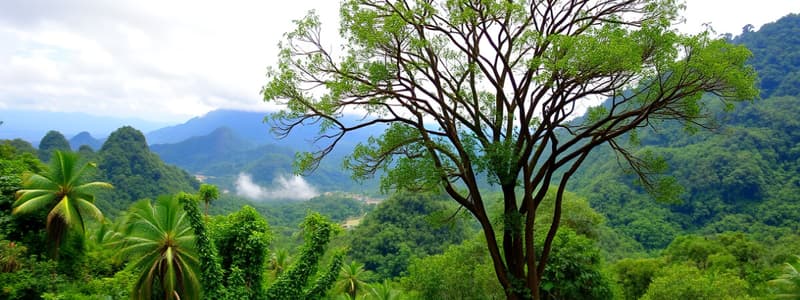Podcast
Questions and Answers
Which province in Region III is known as the 'Rice Granary of the Philippines'?
Which province in Region III is known as the 'Rice Granary of the Philippines'?
- Bataan
- Bulacan
- Pampanga
- Nueva Ecija (correct)
What geographic feature primarily influences agricultural practices in Region I?
What geographic feature primarily influences agricultural practices in Region I?
- Coastal areas
- Mountain ranges (correct)
- Valleys
- Flat plains
What economic activities are primary in the Timog Katagalugan region?
What economic activities are primary in the Timog Katagalugan region?
- Tourism and real estate
- Manufacturing and technology
- Mining and forestry
- Agriculture and fishing (correct)
What type of landscape is most commonly found in Region X?
What type of landscape is most commonly found in Region X?
What characterizes the climate challenge in Region I?
What characterizes the climate challenge in Region I?
What is a notable feature of the geography of Region III?
What is a notable feature of the geography of Region III?
How does Region X connect to other areas in the Philippines?
How does Region X connect to other areas in the Philippines?
Which body of water surrounds Region X?
Which body of water surrounds Region X?
Ano ang pangunahing dahilan kung bakit mahirap ang pagtatanim sa Rehiyon I?
Ano ang pangunahing dahilan kung bakit mahirap ang pagtatanim sa Rehiyon I?
Alin sa mga sumusunod ang hindi nakikita sa Timog Katagalugan?
Alin sa mga sumusunod ang hindi nakikita sa Timog Katagalugan?
Ano ang pangunahing ikinabubuhay ng mga tao sa Timog Katagalugan?
Ano ang pangunahing ikinabubuhay ng mga tao sa Timog Katagalugan?
Ano ang pangunahing katangian ng Rehiyon III?
Ano ang pangunahing katangian ng Rehiyon III?
Alin sa mga sumusunod ang hindi isang anyong lupa na makikita sa Rehiyon X?
Alin sa mga sumusunod ang hindi isang anyong lupa na makikita sa Rehiyon X?
Anong aspeto ng heograpiya ang nag-uugnay sa Rehiyon X sa iba pang bahagi ng Pilipinas?
Anong aspeto ng heograpiya ang nag-uugnay sa Rehiyon X sa iba pang bahagi ng Pilipinas?
Ano ang papel ng bulubundukin ng Cordillera sa Rehiyon I?
Ano ang papel ng bulubundukin ng Cordillera sa Rehiyon I?
Alin sa mga sumusunod ay katangian ng Rehiyon X?
Alin sa mga sumusunod ay katangian ng Rehiyon X?
Flashcards are hidden until you start studying
Study Notes
Physical Features of Regions in the Philippines
- The physical characteristics of regions in the Philippines vary significantly, influenced by geography such as plains, mountains, coastal areas, and valleys.
- These physical traits are crucial as they determine the livelihood of the inhabitants in each region.
Region I
- Located in a narrow plain between the Philippine Sea and the Cordillera mountain range, which protects it from typhoons.
- Agriculture is challenging due to long summer seasons and limited arable land.
Region III
- Known for extensive rice farming, particularly in Nueva Ecija, which is dubbed the "Rice Granary of the Philippines."
- Bataan, situated as a peninsula, is an exception in terms of agricultural practices in this region.
- Home to diverse landforms and bodies of water, such as Mt. Makiling, Mt. Banahaw, Mt. Halcon, and Taal Volcano.
- Primary livelihoods include agriculture and fishing, along with a variety of household industries that contribute to the economy.
Region X (Southern Mindanao)
- Comprises a cluster of islands in Mindanao, characterized by mountainous terrain and some valleys.
- Surrounded by significant bodies of water, including the Pacific Ocean, Bohol Sea, and Camotes Sea.
- Features various landforms such as mountains, hills, and coastal areas.
- Well-connected to other parts of the Philippines and the world through modern airports and ports.
Physical Features of Regions in the Philippines
- The physical characteristics of regions in the Philippines vary significantly, influenced by geography such as plains, mountains, coastal areas, and valleys.
- These physical traits are crucial as they determine the livelihood of the inhabitants in each region.
Region I
- Located in a narrow plain between the Philippine Sea and the Cordillera mountain range, which protects it from typhoons.
- Agriculture is challenging due to long summer seasons and limited arable land.
Region III
- Known for extensive rice farming, particularly in Nueva Ecija, which is dubbed the "Rice Granary of the Philippines."
- Bataan, situated as a peninsula, is an exception in terms of agricultural practices in this region.
- Home to diverse landforms and bodies of water, such as Mt. Makiling, Mt. Banahaw, Mt. Halcon, and Taal Volcano.
- Primary livelihoods include agriculture and fishing, along with a variety of household industries that contribute to the economy.
Region X (Southern Mindanao)
- Comprises a cluster of islands in Mindanao, characterized by mountainous terrain and some valleys.
- Surrounded by significant bodies of water, including the Pacific Ocean, Bohol Sea, and Camotes Sea.
- Features various landforms such as mountains, hills, and coastal areas.
- Well-connected to other parts of the Philippines and the world through modern airports and ports.
Studying That Suits You
Use AI to generate personalized quizzes and flashcards to suit your learning preferences.




